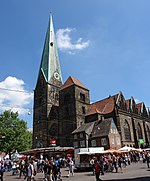Church of Our Lady (Bremen)
| Kirche Unser Lieben Frauen (Liebfrauenkirche) | |
|---|---|
 |
|
| Basic information | |
| Location |
Unser Lieben Frauen Kirchhof 27 Bremen, Germany |
| Geographic coordinates | 53° 4' 35” N, 8° 48' 27” O |
| Country | Germany |
| Website | www.kirche-bremen.de Unser Lieben Frauen |
| Specifications | |
| Length | 59 meters (194 feet) |
| Width | 34 meters (112 feet) |
| Spire(s) | 2 |
| Spire height | 84.2 meters (276 feet) |
Unser Lieben Frauen Kirchhof 27
The Church of Our Lady (German: Kirche Unser Lieben Frauen) is an Evangelical Protestant church situated northwest of the Market Square in Bremen, Germany. Like Bremen Cathedral, today's building dates from the 13th century. The brightly coloured stained-glass windows are the work of the French artist Alfred Manessier. In 1973, the church was listed under the monument protection act.
The church was originally dedicated to Saint Vitus. It served as market church of the city and later also as church of the city council. Around 1020, a new building was erected of which only the crypt still exists, decorated with medieval frescos. The church was extended to form a basilica in the middle of the 12th century. Around 1220, it was consecrated to the Virgin Mary. From 1230 onwards, it was rebuilt in the early Gothic style as a hall church. A westwork with two towers was added. For many years, the northern tower contained the archive of the city council of Bremen, known as the Tresekammer. In the 14th century, the choir was extended.
The interior was damaged by fire in 1944, but much less than the other medieval churches of the city. When the new organ was installed in 1953, the acoustics were so poor that in 1958 the city assigned Dieter Oesterlen to manage the church's refurbishment. The residual medieval plastering and the remains of the frescos were removed, leaving plain brick walls. In 1966, the French artist Alfred Manessier was charged with redesigning the 19 windows that had been destroyed during the Second World War. Inspired by verses from the Bible, he embarked first on the design of the four main windows, employing brightly coloured stained glass representations with expressive linear patterns. Together they depict various manifestations of the Word of God. At the end of the aisle to the north of the altar, the Christmas Window is inspired by "The Word became flesh" (John 1:14), while the Pentecost Window at the east end of the chancel is inspired by the Miracle of Tongues (Acts 2). The Sermon Window symbolises the preached word: "We are ambassadors for Christ" (2 Corinthians 5:20) while the Virgin Mary Window, a rose window at the opposite end of the church draws on the Christmas story: "Mary kept all these sayings, pondering them in her heart" (Luke 2:19). With the assistance of François Lorin from Chartres, Manessier completed his work in 1979.
...
Wikipedia
